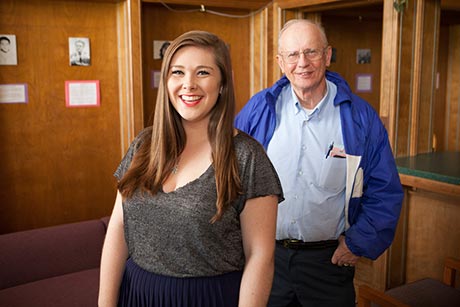Cornell humanitarians honored in Anabel Taylor exhibit
By Kathy Hovis

Twenty-five Cornell alumni who have given their time and energy – and in some cases, their lives – for human rights causes are being honored with a display in Anabel Taylor Hall.
Photos and bios of each alum adorn the walls of the former One World Café on the first floor and plans call for the tributes to take a permanent spot on the first floor walls, said John Weiss, associate professor of history and an organizer of the exhibit.
Several years ago, students taking one of Weiss’ classes on humanitarianism and human rights pressed for a way to honor alumni in these fields. Natalie Rosseau ’16 took up that cause last fall.
“What makes Cornell a unique institution is its commitment to land-grant education and to encouraging service among students,” Rosseau said. “There should be some permanent hall of fame to honor undergraduate and graduate students who went on to live this life of service, especially in light of the sesquicentennial celebration this year. This is part of the Cornell story.”
Rosseau, a history and pre-med major from Chicago, received a $400 grant from Cornell’s Mortar Board honor society for the project. She began researching graduates who became involved in humanitarian and human rights efforts, developing the initial list of 25 from research and interviews on campus. Several other students participated in the project, most notably Matthew Clauson ’15 and Robin Berk ’16.
The honorees are a diverse group, with graduation years from the 1800s to today, working in fields as diverse as medicine, law and agriculture. There’s also a part of the exhibit dedicated to Cornellians in the Peace Corps; Cornell ranks No. 4 in Peace Corps recruits among medium-sized universities and has sent more than 1,500 students volunteers over the years.
The exhibit was opened April 25 during Charter Day Weekend. Organizers showed a video with short bios of each participant that will become part of a website, Rosseau said. This fall, the group brought Liam Mahony ’81, an honoree, to campus to speak to students about his work. Mahoney worked for the Syracuse Peace Council as an undergraduate and was a pioneer in the theory and practice of international protection. His experience includes protection work with Peace Brigades international in Guatemala in the 1980s.
Students plan future induction ceremonies to honor more alumni humanitarians. “There are lots of ways that we see this project growing and expanding,” Rosseau said.
While each of the 25 alums are notable, Rosseau said she was most struck by the story of Michael Schwerner ’61, who was slain in Mississippi in 1964 by members of the Ku Klux Klan as he worked to educate and register African-American voters.
Other notables include:
- Bob Harrison ‘76, president of the Cornell Board of Trustees and CEO of the Clinton Global Initiative, which mobilizes leaders to take action on issues including education, public health, youth employment and natural resource management.
- John Mott, Class of 1888, who won the Nobel Peace Prize in 1946 for his work growing the YMCA and promoting youth peace movements across nations.
- Ida Scudder, M.D. Class of 1899, who treated female patients in her father’s bungalow in India, established the first graduate school of nursing in India and a rural health service that administered public health services to a vast area.
- Sheryl WuDunn ’81, the first Asian-American reporter to win a Pulitzer Prize, worked in banking and journalism and co-wrote the book “A Path Appears” and co-authored “Half the Sky,” about the oppression of women and girls around the world
“It’s really a privilege to be a student at Cornell, but it isn’t an ivory tower,” Rosseau said. “We are responsible for taking what we have learned and using that knowledge to help others.
The exhibit runs through graduation, then will be removed until a permanent location is finalized, Weiss said.
Kathy Hovis is a writer for the College of Arts and Sciences.
Media Contact
Get Cornell news delivered right to your inbox.
Subscribe